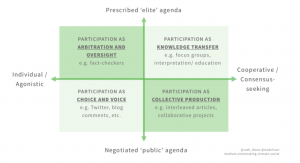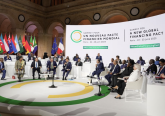Warren Pearce’s new ‘Making Climate Social’ project seeks to investigate the ‘contributors, content, connections and contexts of social media climate change communications’ in order to determine ‘what the social media revolution might mean for the tricky relationship between science, politics, and publics.’ Warren recently invited me to take part in a workshop to discuss his project, and this post arises out of that meeting.
Apart from providing an excellent opportunity for alliteration, what can research into social media tell us about the ‘contributors, content, connections, and contexts’ of climate communication?
Four types of participation
In considering that question, I have been thinking how to classify the different types of participation in climate change discussions. To this end, I adapted a typology developed by Rikki Dean at LSE, which draws on cultural theory (Douglas 1970) to classify ways in which the public participate in policy-making (Dean 2016). Dean’s typology, described in his blog-post and paper, has two dimensions. The negotiability dimension is the degree to which participation is subject to externally imposed rules or, alternatively, is negotiated by the participants themselves. The socialitydimension is the degree to which participation is ‘agonistic’ or ‘solidaristic,’ that is, the degree of conflict or cooperation between participants. Dean identifies four distinct modes of participation (the four possible combinations of ‘high’ and ‘low’ sociality and negotiability) which he terms knowledge transfer, collective decision-making, choice and voice, and arbitration and oversight, each of which represents a legitimate way in which the public can contribute to policymaking.
Dean’s typology offers distinct parallels for understanding how individuals participate in climate change discussions. Adapting Dean’s negotiability dimension to the climate discussion space, we can see that participation may be on issues that are decided by ‘elites’ (whether scientists, politicians, or professional communicators) or are negotiated by all of the participants. And, on the sociality dimension, participation may be individualistic, sometimes combative, or alternatively cooperative, aiming to build consensus. These two dimensions lead to the four quadrants shown in Figure 1.

This is not the first time that cultural theory has been applied to climate change. Other authors have used it to explain why individuals with different world views are likely to vary in their responses to the risks of climate change and their preferred policies (e.g. O’Riordan and Jordan (1999), McNeely and Lazrus (2014)). Marco Verweij and colleagues argued that acknowledging the range of cultural world-views allows us to propose ‘clumsy solutions’ to climate change (Verweij et al. (2006)). As the authors of that paper put it: ‘Clumsy solutions are creative, flexible mixes of four ways of organizing, perceiving and justifying that satisfy the adherents to some ways of life more than other courses of actions, while leaving no actor worse off. As such, they alleviate social ills better than other courses of actions do.’
In this post, however, I am not trying to classify individuals but, following Dean (2016), to classify types of participation (in this case participation in various forms of ‘climate communication’ rather than in policymaking).
So, for example, in the top-right quadrant (highly prescribed agenda, consensus-building response) both the issues and the format for participation are controlled by the ‘elite.’ ‘Elite’ and ‘public’ participants have well-defined (but separate) roles, both in how they are identified and how they participate. Such participation could involve (i) explaining mainstream views on climate science (e.g. Realclimate or the Met Office); (ii) reading and disseminating such information; or (iii) taking part in invited focus groups, interviews, or surveys (e.g. work by Nick Pidgeon and colleagues).
Moving to the lower-right quadrant (collaborative production by equals), the ‘elite’ is no longer clearly distinguishable from the rest of the participants. In this quadrant the agenda is negotiable by all participants and participation is intended to build consensus or mutual understanding. An example was Climate Dialogue, which published contributions from scientists with differing views on topics such as climate sensitivity. This quadrant also includes cooperative efforts to promote mainstream (Consensus Project) or alternative (PSI) scientific consensuses.
The top-left quadrant (arbitration and oversight) contains forms of participation which accept the ‘elite’ issue agenda and rules of the game, but not necessarily the mainstream interpretation. In this type of participation I include fact-checking and challenging scientific findings (e.g. Climate Audit) or policy prescriptions (e.g. Climate Resistance). I would also include independent analyses that generally confirm the mainstream view or ‘fact-check the fact-checkers’ (e.g. Tamino and Moyhu), or reanalyse data but remain aloof from the debate (Climate4you).
Finally, participation in the lower-left quadrant involves individuals setting their own agenda and making their opinions known. Sounds familiar? Welcome to the ‘marketplace of ideas’ that includes Twitter, Facebook, and below-the-line comments on (some) blogs and press articles. Such forums give individuals ‘choice and voice’ as to which issues they discuss and how they express their opinions — opinions which necessarily span the range of views on climate science and policy. No distinction is made between ‘public’ and ‘elite’ voices; experts who participate in these forums do so on an equal footing with the public.
I think there are lessons for both participants and researchers from this typology.
Participants should be alert to the ‘quadrant’ in which their interlocutors are operating and approach the dialogue accordingly. For example, those who think that the only valid ways in which the public should participate in climate discussions are found in the top-right quadrant will interpret any participation in other quadrants as hostile. Notably, treating independent fact-checking as an illegitimate means of participation may have contributed to what have been termed ‘the climate wars.’
Crossing quadrants
Attempts to enter a different quadrant, however, can be fraught with difficulty. Individuals familiar with the conventions and etiquette of one quadrant may find that those norms do not apply in another. Twitter, for example, can be used to disseminate information in a ‘top-right quadrant’ way, but this can antagonize ‘bottom-left’ participants, who have the same access to that platform as the mainstream elite. Communicators who expect to be treated with the same respect in the public space as in a more controlled environment may find the experience unsettling — while others may thrive in the new environment. Conversely, attempts by the public to negotiate the agenda in a ‘top-right quadrant’ forum will be met with understandable resistance. ‘Top-left quadrant’ forums may also be intolerant of those who wish to introduce their own agenda. (This can, of course, also be true of ‘bottom-right’ groups who, once an agenda has been agreed, may resist attempts by outsiders to renegotiate it.)
Reputations are not necessarily transferable between quadrants, and indeed participation in one quadrant can count against a person’s reputation in another. A participant may be accused of promoting ‘false balance’ or ‘giving credence to sceptics’ if they move from the ‘controlled’ to the ‘negotiated’ public space.
Clumsy institutions?
And what are the implications for research into ‘climate communication’ on social media? This typology does not map neatly on to ‘mainstream’ and ‘sceptical’ views, nor on to ‘legitimate’ versus ‘illegitimate’ forms of public participation. But this typology may provide a framework to help us understand some aspects of the complex landscape of climate communication. Do climate discussions become more heated (or perhaps more interesting?) when one type of participation encounters another? Do such clashes give an opportunity for participants to leave their echo chambers and consider different views, or do they simply lead to mutual incomprehension and antagonism? A better understanding of climate communication may help us to progress towards what Verweij and colleagues call ‘clumsy institutions,’ that is, ‘arrangements in which none of the voices […] is excluded, and in which the contestation is harnessed to constructive, if noisy, argumentation.’
Acknowledgements
I am grateful to Rikki Dean for his perceptive comments on an early version of this article (as well as for his typology!). Thanks too to Jonathan Jones for his comments and suggestions.
References
Dean, R.J. 2016. ‘Beyond radicalism and resignation: the competing logics for public participation in policy decisions’ Policy & Politics (early online view).
Douglas, M. 1970. Natural Symbols: Explorations in Cosmology. Barrie & Rockliff, The Cresset Press.
O’Riordan. T. and Jordan, A. 1999. ‘Institutions, climate change and cultural theory: towards a common analytical framework.’ Global Environmental Change 9 (2) 81–93.
McNeely, S.M., and Lazrus, H. 2014. ‘The cultural theory of risk for climate change adaptation.’ Weather, Climate, and Society 6 (4) 506–519.
Verweij, M., Douglas, M., Ellis, R., Engel C., Henriks, F., Lohmann, S., Ney, S., Rayner, S., and Thompson, M. 2006. ‘Clumsy solutions for a complex world: the case of climate change.’ Public Administration 84(4) 817–843.
This article originally appeared in the Making Climate Social blog edited by Warren Pearce. See https://medium.com/making-climate-social/carving-up-the-climate-communication-landscape-e3f9c40ca3cf.





